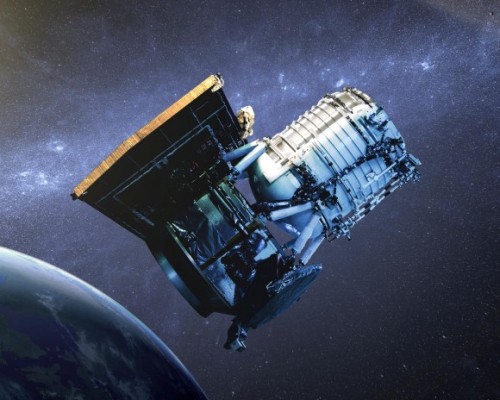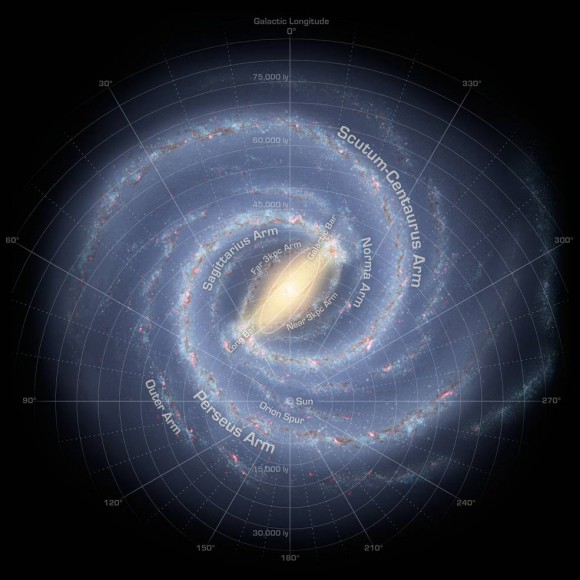
Astronomers using data from NASA’s Wide-field Infrared Survey Explorer, or WISE, recently announced a new method of mapping the Milky Way that has confirmed four primary spiral arms for our galaxy. Using WISE data, the research team discovered more than 400 clouds of dust and gas in the galaxy, places where new stars are being born. They are using these dust-shrouded nurseries of stars to trace the shape of our galaxy’s spiral arms. They describe seven of these embedded star clusters in a new study published online on May 20 in the Monthly Notices of the Royal Astronomical Society.
The results of the study support the four-arm model of our galaxy’s structure. For the last few years, various methods of charting the Milky Way have largely led to a picture of four spiral arms. The arms are where most stars in the galaxy are born. They contain most of the galaxy’s gas and dust, the raw ingredients for new stars.
Two of the arms, called Perseus and Scutum-Centaurus, seem to be more prominent and jam-packed with stars, while the Sagittarius and Outer arms have as much gas as the other two arms but not as many stars.
The new WISE study finds embedded star clusters in the Perseus, Sagittarius, and Outer arms.
Imagine how hard it is to map our own galaxy. It’s like trying to create a map of your house while confined to just one room. NASA said in a statement on June 3:
You might peek through the doors into other rooms or look for light spilling in through the windows. But, in the end, the walls and lack of visibility would largely prevent you from seeing the big picture.
The job of mapping our own Milky Way galaxy from planet Earth, situated about two-thirds of the way out from the galaxy’s center, is similarly difficult. Clouds of dust permeate the Milky Way, blocking our view of the galaxy’s stars.

Denilso Camargo from the Federal University of Rio Grande do Sul in Brazil is lead author of the new study. He said:
The sun’s location within the dust-obscured galactic disk is a complicating factor to observe the galactic structure.
NASA said embedded star clusters are a powerful tool for visualizing the whereabouts of spiral arms because the clusters are young, and their stars haven’t yet drifted away and out of the arms. Stars begin their lives in the dense, gas-rich neighborhoods of spiral arms, but they migrate away over time. These embedded star clusters complement other techniques for mapping our galaxy, such as those used by radio telescopes, which detect the dense gas clouds in spiral arms. Camargo said:
Spiral arms are like traffic jams in that the gas and stars crowd together and move more slowly in the arms. As material passes through the dense spiral arms, it is compressed and this triggers more star formation.
WISE is ideal for finding the embedded star clusters, NASA said, because its infrared vision can cut through the dust that fills the galaxy and shrouds the clusters. What’s more, WISE scanned the whole sky, so it was able to perform a thorough survey of the shape of our Milky Way.
NASA’s Jet Propulsion Laboratory in Pasadena, California managed and operated WISE for NASA’s Science Mission Directorate in Washington. The spacecraft was put into hibernation mode in 2011, after it scanned the entire sky twice, thereby completing its main objectives.
In September 2013, WISE was reactivated, renamed NEOWISE and assigned a new mission to assist NASA’s efforts to identify potentially hazardous near-Earth objects.

Bottom line: Astronomers using data from NASA’s Wide-field Infrared Survey Explorer, or WISE, recently announced a new method of mapping the Milky Way that has confirmed four spiral arms for our galaxy. The new method uses what are called “embedded star clusters,” which are places shrouded by galactic dust, essentially stellar nurseries where new stars are being born.











